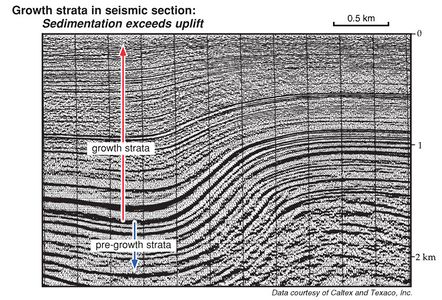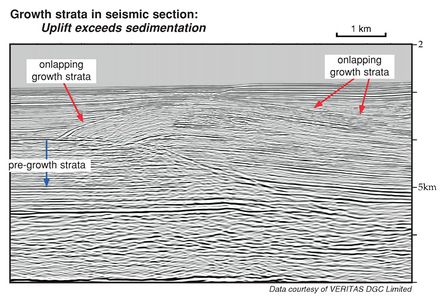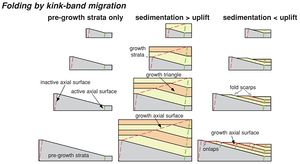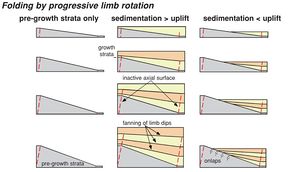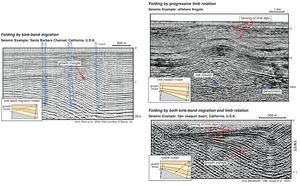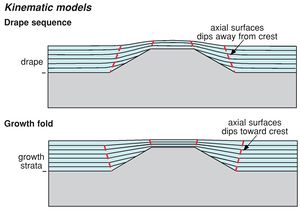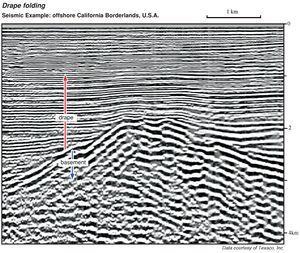Growth strata
| Seismic Interpretation of Contractional Fault-Related Folds: An AAPG Seismic Atlas | |

| |
| Series | Studies in Geology |
|---|---|
| Part | Part 1 |
| Chapter | Structural Interpretation Methods |
| Author | John H. Shaw, Christopher D. Connors, and John Suppe |
| Link | Web page |
| PDF file (requires access) | |
| Store | AAPG Store |
Growth or syntectonic strata are stratigraphic intervals that were deposited during deformation. The ages of growth strata therefore define the timing of deformations. In contractional fault-related folds, growth strata typically thin across fold limbs toward structural highs. The geometries of growth structures are controlled primarily by the folding mechanism and the relative rates of sedimentation and uplift. Thus, growth fold patterns imaged in seismic data are often considered diagnostic of folding mechanism and sediment-to-uplift ratio. In this article, we describe common patterns of growth strata in fault-related folds that are imaged in seismic reflection data.
In cases where the sedimentation rate exceeds the uplift rate, growth strata are typically characterized as sequences, bounded by two or more seismic reflections, that thin toward the structural high. Growth strata are generally folded in one or more limbs of the structure. In Figure 1, growth strata thin onto the fold crest, with the lowermost growth units exhibiting the greatest thickness changes. (2-D seismic data, reprinted from Shaw et al.[1]).
In cases where the uplift rate exceeds the sedimentation rate, growth strata typically thin toward, and onlap, the structural high. Growth strata are generally not present above the fold crest, but are folded in one or more limbs of the structure. In Figure 2, growth strata onlap the backlimb and forelimb of a fault-related fold. The growth strata are overlain by post-tectonic strata.
Growth strata as records of fold kinematics
Two folding mechanisms — kink-band migration and limb rotation — are commonly ascribed to contractional fault-related folds. These folding mechanisms typically yield distinctive patterns of deformed growth strata above fold limbs. Thus, seismic images of growth folds can be used to identify the folding mechanisms, which in turn can dictate the kinematic theory (e.g., fault-bend folding or detachment folding) that is most appropriate to guide the structural interpretation of the seismic data.
In fault-related folds that develop purely by kink-band migration, fold limbs widen through time while maintaining a fixed dip,[2] as illustrated in the sequential model involving pre-growth strata only (Figure 3, left). Material is incorporated into the fold limb by passing through an active axial surface, which at depth is generally pinned to a bend or tip of a fault.[3][4] The fold limb in growth strata is bounded by the active axial surface and the growth axial surface, an inactive axial surface that defines the locus of particles originally deposited along the active axial surface. In these sequential models (Figure 3, left side), the synclinal axial surface is active, and the anticlinal axial surface is inactive.
In the case where sedimentation rate exceeds uplift rate (Figure 3, center), strata are folded through the synclinal axis and incorporated into the widening fold limb. The dip of folded growth strata is equal to dip of the fold limb in pre-growth strata. The width of the dip panel for each growth horizon corresponds to the amount of fold growth that occurred subsequent to the deposition of that marker. As a result, younger horizons have narrower fold limbs than do older horizons, forming narrowing upward fold limbs or kink bands in growth strata (growth triangles). In the case where uplift rate exceeds sedimentation rate (Figure 3, right side), each increment of folding produces a discrete fold scarp located where the active axial surface projects to the Earth’s surface.[5] Subsequent deposits onlap the fold scarp, producing stratigraphic pinchouts above the fold limb. Fold scarps and stratigraphic pinch-outs are displaced laterally and folded as they are incorporated into widening limbs.
Contractional fault-related folding theories that exclusively invoke kink-band migration include fault-bend folding,[3] constant-thickness and fixed axis fault-propagation folding,[4] and basement-involved (triple junction) folding.[6]
In fault-related folds that develop purely by limb rotation with fixed hinges (i.e., inactive axial surfaces), the dip of the fold limb increases with each increment of folding as illustrated in the sequential model involving pre-growth strata only (Figure 4, left side). In the case where sedimentation rate exceeds uplift rate (Figure 4, center), strata are progressively rotated with each increment of folding. Thus, older growth horizons dip more steeply than do younger horizons, yielding a pronounced fanning of limb dips in growth strata. Fold limb width, however, remains constant. In the case where uplift rate exceeds sedimentation rate, growth strata also exhibit a fanning of limb dips. However, growth strata typically onlap the fold limb. Contractional fault-related folding theories that exclusively invoke limb rotation include certain classes of detachment folds.[7][8]
Growth structures in seismic data
Growth structures imaged in seismic sections commonly exhibit patterns that are similar to the kink-band migration or limb-rotation models that were described on the previous page. In other cases, folds may develop by a combination of kink-band migration and limb rotation, resulting in hybrid patterns of growth structure. This sub-section presents three seismic profiles as examples of kink-band migration, limb rotation, and hybrid growth structures.
The seismic section Figure 5, left shows a narrowing upward fold limb, or growth triangle, where bed dips within the fold limb generally do not shallow upward, consistent with folding by kink-band migration. Dipmeter data in the wells corroborates the reflector dips. In the section in Figure 5, top right, a fanning and upward shallowing of limb dips within growth strata are consistent with folding by progressive limb rotation. The core of the anticline is filled with salt, which presumably thickened during deformation, leading to progressive rotation of the overlying fold limbs. The growth structure in the section in Figure 5, lower right contains both a growth triangle and a fanning of limb dips, suggesting folding by a combination of kink-band migration and limb rotation mechanisms. Kinematic theories that employ hybrid folding mechanisms include shear fault-bend folds,[9] certain classes of detachment folds,[7][8] and trishear fault-propagation folds.[10][11][12]
Distinguishing drape from growth strata
Sedimentary drape sequences are stratigraphic intervals that were deposited above a structure after deformation ceased, yet they are warped due to primary sedimentary dip and/or compaction. Drape sequences exhibit a wide range of patterns depending on the sedimentary environment and facies. In some cases, drape sequences have patterns that are similar to those of growth strata deformed by limb rotation. In this sub-section, we illustrate the potential similarity of drape and growth patterns, and show an example of a drape sequence in a seismic section.
In Figure 6, the top model shows a post-tectonic drape sequence above a rigid basement high. The drape sequence thins toward the crest of the structure, with younger strata having less relief than older units. The lower model in Figure 6 shows growth strata above a fold developed by progressive limb rotation. The two stratigraphic patterns are similar, and in some cases difficult to distinguish. Incorrect interpretations of drape and growth sequences can lead to flawed estimates of structural timing and kinematics. Thus, care should be taken in trying to distinguish between drape and growth sequences.
One common difference between drape and growth sequences is the orientation of axial surfaces. Axial surfaces in drape sequences often are vertical or dip away from the structural crest, reflecting a state of tension and due, in some cases, to compaction.[13] In contrast, axial surfaces in contractional folds generally dip toward the structural crest, reflecting a state of compression. Thus, careful interpretation of axial surfaces, along with consideration of regional tectonic history, can, in some cases, help to distinguish between drape and growth sequences. The seismic section in Figure 7 images a siliciclastic drape sequence that onlaps and overlies a ridge of metamorphic basement rocks.
References
- ↑ Shaw, J. H., S. C. Hook, and B. Satrio, 1997, Complex structural reactivation defined by growth strata: AAPG Annual Meeting Abstracts, v. 6, p. 106.
- ↑ Suppe, J., G. T. Chou, and S. C. Hook, 1992, Rates of folding and faulting determined from growth strata, in K. R. McClay, ed., Thrust tectonics; London, Chapman, and Hall, p. 105-121.
- ↑ 3.0 3.1 Suppe, J., 1983, Geometry and kinematics of fault-bend folding: American Journal of Science, v. 283, p. 684-721.
- ↑ 4.0 4.1 Suppe, J., and D. A. Medwedeff, 1990, Geometry and kinematics of fault-propagation folding: Ecolg. Geol. Helf., v. 83, p. 409-454.
- ↑ Shaw, J. H., E. Novoa, and C. Connors, 2004, Structural controls on growth stratigraphy in contractional fault-related folds, in K. R. McClay, ed., Thrust tectonics and hydrocarbon systems: AAPG Memoir 82, p. 400-412.
- ↑ Narr, W., and J. Suppe, 1994, Kinematics of basement-involved compressive structures: American Journal of Science, v. 294, p. 802-860.
- ↑ 7.0 7.1 Dahlstrom, C. D. A., 1990, Geometric constraints derived from the law of conservation volume and applied to evolutionary models for detachment folding: AAPG Bulletin, v. 74, p. 336-344.
- ↑ 8.0 8.1 Hardy, S., and J. Poblet, 1994, Geometric and numerical model of progressive limb rotation in detachment folds: Geology, v. 22, p. 371-374.
- ↑ Suppe, J., C. Connors, and Y. Zhang, 2004, Shear fault-bend folding, in K. R. McClay, ed., Thrust tectonics and hydrocarbon systems: AAPG Memoir 82, p. 303-323.
- ↑ Ersley, E. A., 1991, Trishear fault-propagation folding: Geology, v. 19, no. 6, p. 617-620.
- ↑ Hardy, S., and M. Ford, 1997, Numerical modeling of trishear fault-propagation folding and associated growth strata: Tectonics, v. 16, no. 5, p. 841-854.
- ↑ Allmendinger, R. W., 1998, Inverse and forward numerical modeling of trishear fault-propagation folds: Tectonics, v. 17, no. 4, p. 640-656.
- ↑ Laubach, S. E., D. D. Schultz-Ela, and R.Tyler, 2000, Differential compaction of interbedded sandstone and coal, ‘’in’’ J. W. Cosgrove and M. S. Ameen, eds., Forced folds and fractures: Geological Society of London Special Publication 169, p. 51-60.
